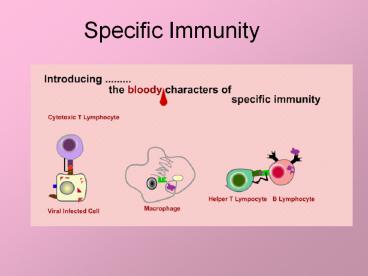Specific Immunity - PowerPoint PPT Presentation
1 / 17
Title:
Specific Immunity
Description:
Stick to surface of pathogen so it can be recognized by phagocytic cells ... and the simple antibody response is usually sufficient to fight an infection. ... – PowerPoint PPT presentation
Number of Views:19
Avg rating:3.0/5.0
Title: Specific Immunity
1
Specific Immunity
2
Who are the players?
- Antigens foreign proteins, usually part of
virus or bacteria - Antibodies Proteins made by immune cells that
recognize or bind with particular antigens.
Original diversity of antibody-producing cells
depends on recombination of genetic sequences
during cell development - Macrophages phagocytic cells in blood)
- Cytotoxic T-cells killer white blood cells
- Helper T-cells present antigens so that good
match can be found among antibody-making cells - B-cells recognize antigens and make antibodies
- MHC Major Histocompatiblity Complexallows body
to recognize own cells so that their proteins
dont trigger immune response, also important in
clonal selection - Clonal selection process by which B and T-cells
that make antibodies that recognize bodys own
antigens (autoantigen) are eliminated during
development.
3
Antigens
- Proteins (or sometimes carbs) that are recognized
(glom onto) specific antibody - Exogenous antigens On outside or free of
pathogen - Endogenous antigens From pathogens that live
and reproduce inside host cell. Immune cells can
only see these antigens when they are presented
on surface of host cell surface, incorporated
into cell membrane - Auto-antigens Bodys own antigens. Immune
cells that recognize these antigens are
eliminated during immune system development (by
antibody editing or clonal selection/deletionmore
below)
4
Antibodies
- Each antibody has specific antigen binding site
formed by variable regions of heavy and light
amino acid chains. Variation among antibodies in
these binding sites comes from random
recombination from billions of possible DNA/gene
combinations. - Rest of heavy and light chains are constant
giving antibodies their characteristic shape and
function
5
What do antibodies do?
- Disable pathogens by glomming (agglutinating)
them together - Neutralize toxins by glomming onto them on the
surface of pathogens - Stick to surface of pathogen so it can be
recognized by phagocytic cells - Immunoglobulins are classes of antibodieseach
class has more specific immune function
6
(No Transcript)
7
Macrophage on the attack!!
8
Where do antibodies come from?
- Made by B-cell lymphocytes
- 1011 B-cells in body, each with specific
antibody, present for life - Each B-cell has 100,000s of copies of its
antibody embedded in cell membrane, called B-Cell
Receptors (BCR) - When a BCR reacts or gloms onto an antigen that
it recognizes, that cell iss timulated to produce
free antibodies that are secreted into blood as
immunoglobulin (Ig)
9
Antibody editing by clonal selection or deletion
- Variety of B-cells produced by random
recombination of genes for variable regions of
antibody - During B-cell development, certain clonal lines
are eliminated because their antibodies glom onto
the bodys own antigens - B-cell production and clonal selection occurs in
bone marrow during early years of life
10
B-cell and antibody immune function simple,
right?
- Each B-cell make specific antibody which is
present on cell surface as BCR (B cell receptor) - When that cell recognizes an antigen (the
antigen sticks to the BCR), then it begins
producing free antibody (immunoglobulins or Igs)
to secrete into the blood - Those Igs work to eliminate the source and
possible damage caused by this antigen via
agglutination, neutralization and opsonization - BUTusually B-cells cannot recognize antigens on
their ownand the simple antibody response is
usually sufficient to fight an infection. - THUST-cells (oh, no).
11
T-cell lymphocytes
- Also made in bone marrow, but mature in thymus
(thus T) - Have TCR (T-cell receptor), much like BCR), but
dont produce Igs - Also about 1011 T-cells, each with its own
specific antigen recognition site, produced by
random recombination of genetic sequence and
edited via clonal selection in thymus - 90 of lymphocytes in blood are T-cells. Also in
lymph nodes, spleen, Peyers patches of
intestines - Three types of T-cells
12
Cytotoxic T-cells (CD8)
- Recognize and kill other cells of the bodywhy?
- Those cells are infected by virus or other
intra-cellular pathogen - Cells process antigen from virus and present
it on cell surface embedded in cell membrane so
that TCRs or antibodies can recognize that
non-self antigen
13
Helper T-cells (CD4)
- Type 1stimulate cytotoxic T-cells
- Type 2stimulate B-cells
- Helper T-cells recognize antigens, but can do
nothing about it on their own. They secrete
cytokines (such as interleukin) to direct what
kind of immune response should be activated. - For most infections, Helper Ts are crucial for a
robust response. - Thus, in AIDS, these cells are killed, as they
themselves present viral antigens and invite
cytotoxic T-cells or macrophages to ingest them. - Without the helper T-cells, good response to most
infections cannot be mounted.
14
Antigen processing and MHC
- Phagocytes that have ingested pathogens, as well
as cells infected with virus can process and
present antigens on their cell membrane - MHC molecules aid in this process
- By presenting antigens, the immune response is
greatly accelerated - Especially important in stimulating early
response to previous pathogens (immunological
memorycoming next!)
15
Antigen processing and MHC
16
Review specific immune response
- From the molecules of HIV text
- http//www.mcld.co.uk/hiv/?qhelper20T20cells
17
Nice graphics and animations
http//science.nhmccd.edu/biol/inflam.html
http//fajerpc.magnet.fsu.edu/Education/2010/2010_
INDEX.HTM

